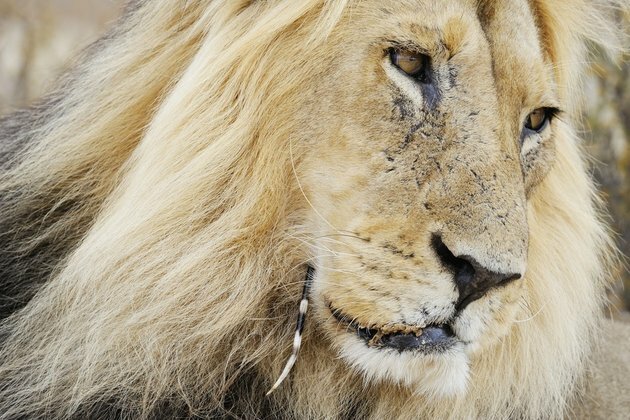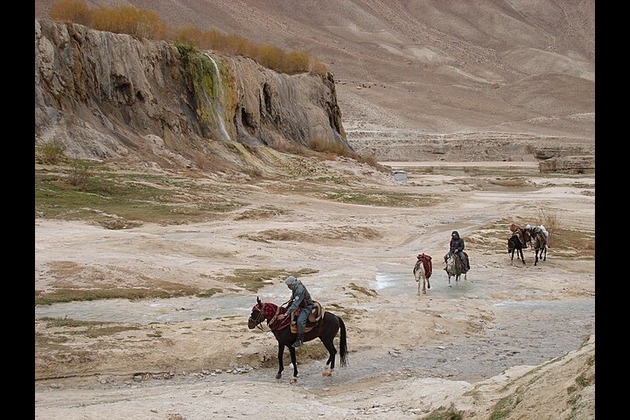Lions sometimes suffer if they attack a porcupine. So why do they do it?
The Conversation
12 Jun 2019, 18:04 GMT+10

Not much can mess with a lion. They're powerful top predators that can bring down large prey like wildebeest, zebra, and even buffalo.
But they're not invincible, as our new study into the interactions between lions and porcupines show. In the battle between these two very different beasts, the spiked rodents can come out ahead.
We examined historical records of lions that have been injured by porcupines, which allowed us to develop a better picture of the conditions that lead lions to try and hunt porcupines - and what happens to the lions who get impaled by the porcupines' quills.
There are stories and records of lions getting injured by porcupines going back hundreds of years. In many of these cases the lions' injuries made it harder for them to hunt or eat. They sometimes turned to easier prey like livestock, including cattle - or eventually humans.
The clashes between porcupines and lions are common knowledge. But before our study, no one had systematically reviewed all the records of lions injured by porcupines to better understand the two species' relationship. Our team scoured scientific literature, stories in the popular press, and even YouTube videos looking for evidence of lion-porcupine interactions. We also used CT scans to assess the effects porcupine quills had on individual lions by reviewing museum specimens. Our research was drawn from different parts of the continent, including Kenya, Namibia and South Africa.
The team found evidence of about 50 lions that had been injured or killed by porcupines since the 17th century. By exploring these cases, we were able to identify why lions sometimes hunt porcupines. One reason appears to be prey deficient landscapes, given that lions prefer to hunt larger hooved animals. This insight has broader ecological significance - knowing this may help local authorities to put better strategies in place and treat lions that are wounded by porcupines before they become incapacitated and desperate.
Historic happenings
African porcupines are large rodents that can weigh up to about about 20kgs. Predators - including humans - seek them out for their tasty meat. But this is no easy meal. Porcupines' backs are covered in sharp quills made of keratin, the same material as fingernails, though much stronger. These quills, which can be needle-sharp, can detach and get stuck deep into a predator's flesh.
We dug way back into historic literacy, including very early sources. One member of our team, Tom Gnoske, who is an assistant collections manager at Chicago's Field Museum, uncovered a treasure trove of historical information, including the translation of a diary from June-August of 1656. In it, an official from the Dutch East Company in Cape Town wrote about three different lions that had been stuck with porcupine quills.
Overall, we found evidence of about 50 lions that had been injured or killed by porcupines. Several trends appeared to emerge from this data.
First, we found that lions living on harsher, drier terrain with limited numbers of large herbivores (normally the lions' preferred prey), such as the Kgalagadi Transfrontier Park in Botswana and South Africa, seemed to rely more on porcupines for food, at least periodically. This was perhaps because other prey weren't available.
Second, it emerged that young male lions were more likely to try to hunt porcupines than older lions or lionesses. There was a tendency for these males to be wounded or killed by porcupines more often - a sort of a "young foolish male syndrome". To compound matters, young males weren't just taking part in risky behaviour: they tended to be alone when they did so. This made them more vulnerable when hurt. In social contexts, a lion can remove porcupine quills with the help of another lion.
CT scans
It wasn't just historical content that helped us conduct this study. We also used CT scans to carefully examine the effects that porcupine quills have had on lions. For instance, we scanned the skulls of two man-eating lions from Kenya killed in 1965, to assess the injuries they had sustained after they had encountered porcupines.
One had been stuck through the nose with a nine-inch quill, and the other had an inch-long segment of a quill embedded in the nerve pulp of its broken canine tooth.
The scans showed evidence of bone infections that would have impaired the injured lions' ability to eat (or, in the case of the lion with a quill through its nose, to smell its prey).
We have evidence that some lions had attacked humans because of their injuries which made it difficult for them to take down their usual prey.
This is useful information to help understand what can lead lions to harm people. From a conservation perspective it is crucial for lions with embedded porcupine quills, especially in the paws or face, to be treated before they become problem animals. This is already happening in some places, like in Kenya through the David Sheldrick Wildlife Trust's Mobile Veterinary Unit.
And the study has broader ecological significance, too. The data we've collected suggests that by the time the lions are relegated to eating porcupines rather than the big meaty, hooved animals they prefer, there's already a problem with the local food supply. Historic records tell us that when environmental conditions deteriorate, particularly in areas where lions and their preferred prey are already living on the edge, they often find themselves in serious trouble with nearby humans or their livestock.
Kate Golembiewski and Thomas Gnoske also contributed to this article.
Authors: Julian Kerbis Peterhans - Professor, Roosevelt University | Gastone Celesia - Professor Emeritus, Neurology and Volunteer at the Field Musuem, Loyola University Chicago 
 Share
Share
 Tweet
Tweet
 Share
Share
 Flip
Flip
 Email
Email
Watch latest videos
Subscribe and Follow
Get a daily dose of Florida Statesman news through our daily email, its complimentary and keeps you fully up to date with world and business news as well.
News RELEASES
Publish news of your business, community or sports group, personnel appointments, major event and more by submitting a news release to Florida Statesman.
More InformationInternational
SectionTurkey, France battle wildfires amid early Europe heatwave
ISTANBUL/PARIS/BRUSSELS: As searing temperatures blanket much of Europe, wildfires are erupting and evacuation orders are being issued...
Venetians protest Bezos wedding with march through the town
VENICE, Italy: Over the weekend, hundreds of protesters marched through the narrow streets of Venice to voice their opposition to billionaire...
New French law targets smoking near schools, public spaces
PARIS, France: France is taking stronger steps to reduce smoking. A new health rule announced on Saturday will soon ban smoking in...
Trump hints at DOGE investigation of Musk subsidies
WASHINGTON, DC - U.S. President Donald Trump on Tuesday claimed Elon Musk's success has been built on government subsidies. Without...
Native leaders, activists oppose detention site on Florida wetlands
EVERGLADES, Florida: Over the weekend, a diverse coalition of environmental activists, Native American leaders, and residents gathered...
Beijing crowds cheer AI-powered robots over real soccer players
BEIJING, China: China's national soccer team may struggle to stir excitement, but its humanoid robots are drawing cheers — and not...
Business
SectionWall Street diverges, but techs advance Wednesday
NEW YORK, New York - U.S. stocks diverged on Wednesday for the second day in a row. The Standard and Poor's 500 hit a new all-time...
Greenback slides amid tax bill fears, trade deal uncertainty
NEW YORK CITY, New York: The U.S. dollar continues to lose ground, weighed down by growing concerns over Washington's fiscal outlook...
Taliban seeks tourism revival despite safety, rights concerns
KABUL, Afghanistan: Afghanistan, long associated with war and instability, is quietly trying to rebrand itself as a destination for...
Nvidia execs sell $1 billion in stock as AI boom drives record prices
SANTA CLARA, California: Executives at Nvidia have quietly been cashing in on the AI frenzy. According to a report by the Financial...
Tech stocks slide, industrials surge on Wall Street
NEW YORK, New York - Global stock indices closed with divergent performances on Tuesday, as investors weighed corporate earnings, central...
Canada-US trade talks resume after Carney rescinds tech tax
TORONTO, Canada: Canadian Prime Minister Mark Carney announced late on June 29 that trade negotiations with the U.S. have recommenced...













